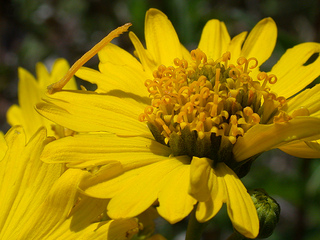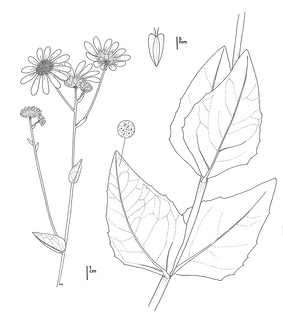(Verbesina dissita)
 Verbesina dissita. CDFW photo by Meredith Osborne.
Verbesina dissita. CDFW photo by Meredith Osborne.
 Verbesina dissita. CDFW illustration by Mary Ann Showers. (Click to enlarge)
Verbesina dissita. CDFW illustration by Mary Ann Showers. (Click to enlarge)
Big-leaved crownbeard is a California threatened plant species, which means that killing or possessing plants from the wild is prohibited by the California Endangered Species Act (CESA). The species is also listed as threatened under the federal Endangered Species Act. Big-leaved crownbeard is a semi-woody shrub with bright yellow flowers that typically appear between May and July, but have been observed as early as February and as late as August. Although the plant is considered a shrub, the aboveground portions of the plant die at the end of each growing season, and resprout each year from underground plant parts called rhizomes. Because the plant sprouts from these rhizomes, what may appear to be separate aboveground plants may actually be from the same genetically-unique individual. The biggest portion of big-leaved crownbeard’s historical range is in Baja California, Mexico, and the only location where the plants are known to occur in the United States is near Laguna Beach in Orange County, California. At the time of this webpage posting, there were two California occurrences of big-leaved crownbeard listed in the California Natural Diversity Database, which are less than a mile away from each other, and both are within two miles of the Pacific Ocean. Big-leaved crownbeard has been found associated with southern maritime chaparral plant species such as Adenostoma fasciculatum var. obtusifolum (chamise), Salvia mellifera (black sage), Ceonothus megacarpus (big pod ceonothus), Cneoridium dumosum (bush rue), Rhamnus crocea (red berry), Erigonum fasciculatum (California buckwheat), and Isomeris arborea (bladderpod).
The populations of big-leaved crownbeard in California occur in close proximity to development, which has already occurred at most of the locations in the area with suitable topography. Fuel modification as a fire prevention method is now the most serious threat to big-leaved crownbeard. Vegetation at the urban interface may be irrigated or thinned with hand equipment or goats. These activities eliminate dense overstory vegetation, promote non-native plant establishment, potentially destabilize slopes, and also have the potential to directly eliminate big-leaved crownbeardplants. A catastrophic fire in the area could also severely impact big-leaved crownbeard by burning through all or a portion of the remaining populations, and could lead to the currently occupied shrubland shifting to grassland habitat that is unlikely to be suitable for big-leaved crownbeard. Other threats to the species include competition with non-native plants, climate change, and the vulnerability of small populations to random events and genetic effects.
Efforts should be made to survey for additional populations of big-leaved crownbeard in suitable habitat, especially in steep, isolated canyons. Continued efforts should also be made to minimize the negative effects of fuel modification on the species. The clonal structure and genetic variability of big-leaved crownbeard should be studied to address potential threats related to small population size. Standardized monitoring programs should be also be established and habitat required for healthy stands of big-leaved crownbeard should be restored.
CDFW may issue permits for big-leaved crownbeard pursuant to CESA, and you can learn more about the California laws protecting big-leaved crownbeard and other California native plants. Populations of big-leaved crownbeard occur in CDFW’s South Coast Region. More information is also available from the U.S. Fish and Wildlife Service’s Species Profile for Big-Leaved Crownbeard.
Updated 01/15/2014